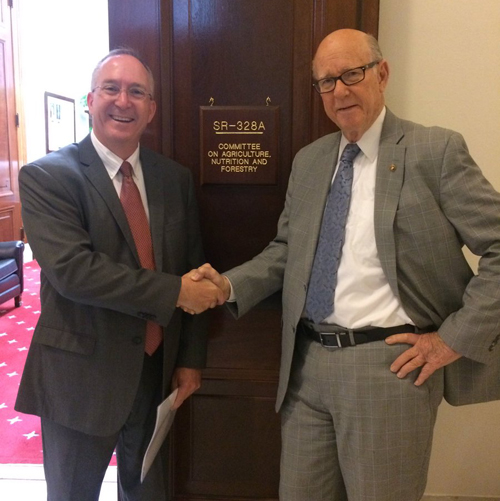WASHINGTON, Oct. 11, 2017 - Organic farming advocates, including the Organic Trade Association (OTA), organic grain distributors and university extension programs, are taking steps to reduce organic fraud, including new traceability methods, and create a more robust U.S. organic grain supply.
As efforts to write the 2018 farm bill get underway, experts say it will be important for lawmakers to continue to prioritize existing organic certification standards and practices while expanding others.
Concerns about fraud intensified last year when 16,250 metric tons of supposedly organic soybeans exported from Ukraine and then trans-shipped through Turkey were found to have been fumigated with a substance prohibited under U.S. organic regulations. A recent USDA Inspector General's report on the National Organic Program also raised concerns about the state of current compliance practices.
Following the discovery of the phony organic imports, the OTA formed an Anti-Fraud Task Force dedicated to seeking foreign and domestic compliance with USDA organic standards by developing a best-practices guide to use in managing and verifying supply chain integrity. The guide will include a vulnerability assessment and an alert reporting system.
While the U.S. market for organics continues to grow, accounting for about $47 billion in sales in 2016, domestic production of organic feed grain continues to lag, with the most recent organic farmland acreage percentage at less than one-half of 1 percent of all available acres. The increased dependence on foreign sources of organic grains necessitates a change in approach, experts say.
Kenneth Dallmier, with the Clarkson Grain Co., an organic corn and soybean distributor and processor in central Illinois and a member of the OTA task force, this summer submitted a plan to prevent import fraud to the Senate Agriculture Committee. Dallmier says organic producers, companies and American consumers could improve compliance if methods such as blockchain technology were used to complement existing verification methods.

Dallmier poses with Senate Ag Committee Chair Pat Roberts at the July hearing. Source: Twitter
“We need to be asking how we use distributive ledger technologies to offer a framework for people who either do not know or may not trust each other to do business,” Dallmier said. “How do we use that framework to increase the traceability of grain shipments from the producer to the buyer?”
A blockchain-based system for imports would feature a radio frequency tag, currently being prototyped by startup company Amber Agriculture at the University of Illinois, that is the size of a key fob, and would be associated with an organic certifier. It would act as an unalterable common ledger, listing origin and changes to any shipment. This open and transparent clearinghouse would ultimately need to be under the jurisdiction of an official such as a USDA undersecretary. This official would have the authority and the visibility to work with his or her counterparts in foreign countries and to coordinate across other U.S. departments. Such a system would be a beneficial addition to one that is now largely paper-based and fraught with possible avenues for fraud, Dallmier said.
Jake Lewin, president of California Certified Organic Farmers, said the USDA’s organic verification and compliance process – notwithstanding needed technological innovations – is arguably the most vigorous in the world. He said its real-time, searchable Organic Integrity Database is the industry standard.
By contrast, in the European and Canadian systems, there is no publicly-available tool, Lewin said. There are differences throughout countries worldwide about what is reported and what information is held back.
Everyone from inspectors to the public can search the USDA database and immediately see who is in compliance with current organic standards and what nations or areas provide what commodities in what quantities. And while technological innovations would certainly be beneficial, making sure there are sufficient industry inspectors and certifiers is also of paramount importance, Lewin said.
Meanwhile, University extension programs, such as those at Western Illinois University and the University of Wisconsin at Madison, are looking to increase organic grain production by creating relationships between researchers and communities of farmers. Many of those producers are of the millennial generation and are enthusiastically pursuing organic goals, said Erin Silva, a professor of plant pathology at the University of Wisconsin and an organic and sustainable cropping systems specialist.
The University of Wisconsin’s USDA Beginning Farmer-Rancher Development Program, begun in 2015, combines classroom instruction, farmer-led outreach and a one-of-a-kind network of organic experts from around the state, Silva said.
“Because our program is focused on training organic farmers, it has been able to create more communication and community within the organic grain sector within the upper Midwest – opportunities to connect across the industry with suppliers and marketers,” Silva said. “That is something that has been lacking with organic grain – the cooperative community.”
#30
For more news, go to www.Agri-Pulse.com

